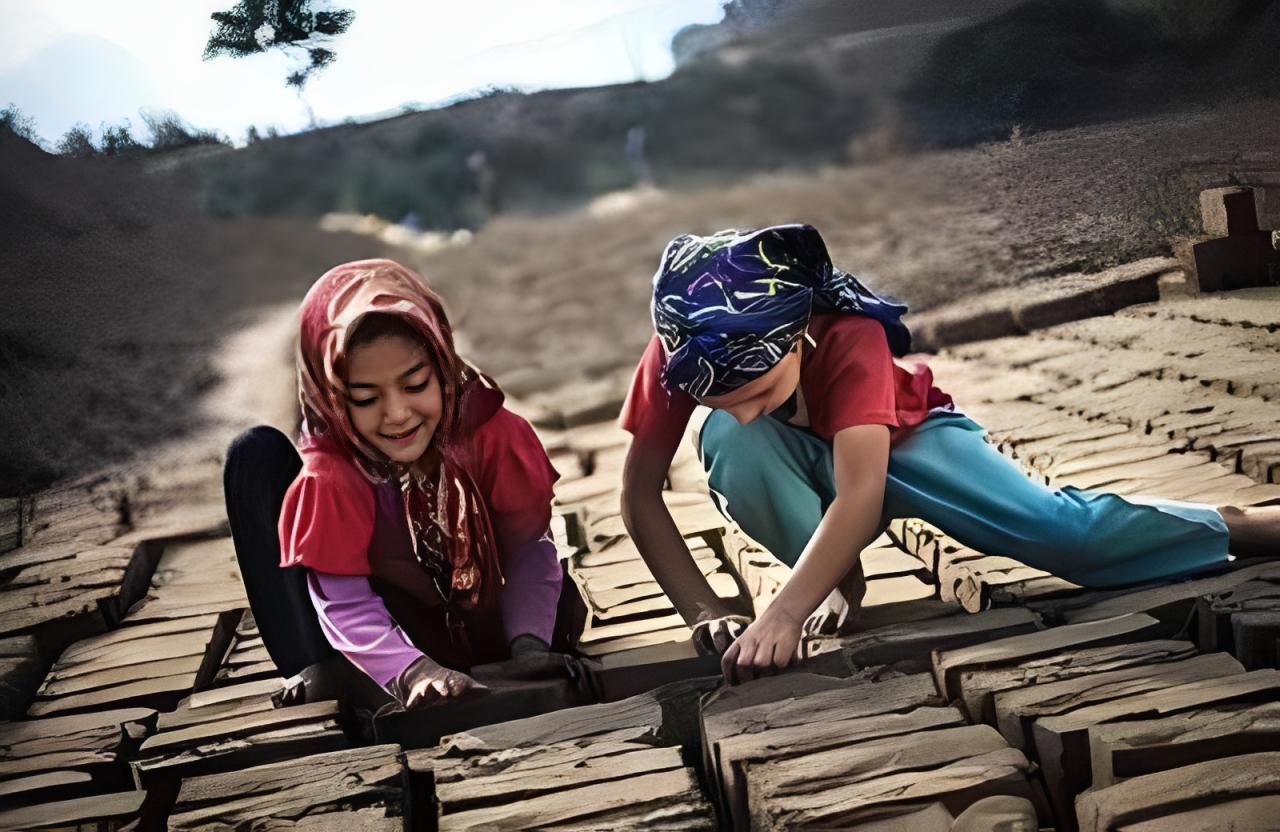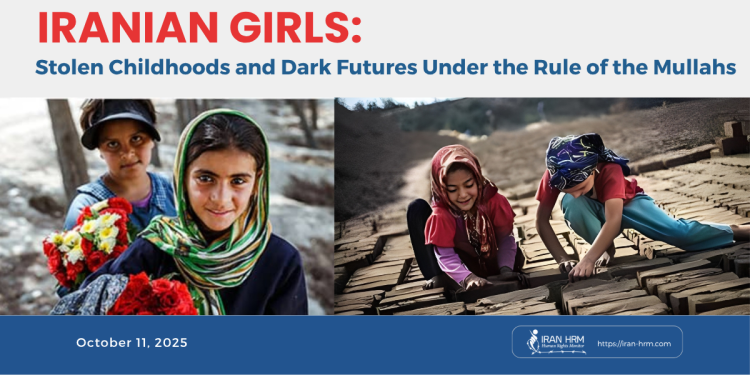Human Rights Report – International Day of the Girl Child, October 11, 2025
On the International Day of the Girl Child, October 11, 2025, when the world reaffirms its commitment to equality, education, and protection for girls, millions of young girls in Iran continue to live under systematic discrimination, child marriage, forced labor, and state-sanctioned violence. Under the rule of the mullahs’ regime, Iranian girls face institutionalized misogyny from early childhood—where laws, religion, and policy combine to strip them of education, safety, and dignity before they even reach adulthood.
Legal Framework and Institutionalized Discrimination
Although Iran acceded to the Convention on the Rights of the Child in 1993, its domestic laws remain in blatant contradiction with its international obligations. Article 1041 of the Civil Code allows the marriage of girls under 13 with a guardian’s consent and a court’s approval. Article 1210 sets the age of puberty for girls at 9 lunar years, and Article 147 of the Islamic Penal Code establishes criminal responsibility from the same age. These provisions deny Iranian girls legal protection and expose them to forced marriage, domestic violence, and prosecution as minors. Even Article 301 of the Penal Code exempts fathers and paternal grandfathers from capital punishment for killing their daughters. Such laws make the Iranian judiciary an instrument of oppression, not protection — a structural violation of both domestic justice and international law.
Child Marriage: Legalized Violence
Child marriage remains one of the regime’s most egregious crimes against girls. According to official figures from Iran’s Statistical Center, 25,900 girls under 15 were married in 2022. Independent experts estimate that the real number is five to six times higher, with roughly 100 underage marriages registered every 24 hours. Between 2017 and 2022, more than 130,000 girls under 15 were married, and over 1,500 girls aged 10–14 gave birth. The majority of these cases occur in deprived provinces such as Sistan-and-Baluchestan, Khuzestan, East Azerbaijan, and Kermanshah. Many families, driven by poverty and incentivized by government marriage loans, sell their daughters into marriage. Cases of self-immolation and suicide among child brides — including Anahita Shahidi in Yasuj and teenage girls from Taybad and Saqqez — have exposed the devastating human toll of this policy. The Women’s Committee of the National Council of Resistance of Iran (NCRI) rightly describes child marriage as “a legalized form of sexual violence against children.”

Poverty, Denied Education, and Lost Futures
Education is a fundamental right, yet in Iran millions of girls are denied it. Estimates indicate that 900,000 to one million children are out of school, half of them girls. In provinces such as Sistan-and-Baluchestan, Khuzestan, and Hormozgan, hundreds of girls’ schools are closed or lack basic sanitary facilities. Long distances to secondary schools, child marriage, and household labor force many girls to drop out. The tragic self-immolation of Shiva Baloyeh, a 14-year-old from Marivan, after being barred from continuing her education, became a symbol of systemic discrimination. By commercializing education and defunding public schools, the regime has turned learning into a privilege of class and wealth — denying poor girls the right to a future.
Forced and Hidden Labor
In the absence of social protection, millions of Iranian children are forced to work — many of them girls. While official reports list only 12,663 registered child laborers, independent assessments suggest that over seven million children are working nationwide, at least half of them girls. They toil in streets, workshops, farmlands, and private homes, enduring violence, exploitation, and sexual abuse. Most work over ten hours a day without insurance, education, or medical care. The regime’s claim of combating child labor is contradicted by budget cuts and the closure of social service centers. Behind official silence lies a vast, invisible network of exploitation sustained by poverty and impunity.

Violence, Law, and Impunity
Under the judiciary of the mullahs’ regime, violence against girls often goes unpunished. In 2021, more than 75,000 cases of domestic and child abuse were recorded — with girls making up the majority of victims. Yet many offenders are shielded by legal loopholes or religious justifications. Court cases involving the sexual abuse of young girls by teachers, clerics, or relatives have repeatedly ended in light sentences or dismissal. This legal culture of impunity reinforces the social normalization of violence against girls.

Stateless and Invisible: The Unregistered Girls
More than one million people in Iran lack birth certificates or national ID numbers, including about 400,000 children. In Sistan-and-Baluchestan alone, some 55,000 children remain unregistered, excluded from school, health care, and legal identity. One example is Ameneh Yarmohammadzahi, a top student from Zahedan who was expelled from school simply for lacking a national ID number. Such bureaucratic denial erases entire generations of girls from public records — and from protection.
Conclusion and Calls for Action
The condition of Iranian girls is the direct result of a system built on misogyny and legalized inequality. Forced marriage, child labor, school deprivation, and statelessness form a chain of suffering forged by the regime of Velayat-e Faqih. This report urges the international community to take immediate measures:
1. Criminalize all marriages under the age of 18 and abolish Article 1041 of the Civil Code.
2. Amend discriminatory legal provisions including Articles 1210, 147, 301, and 907.
3. Guarantee free and compulsory education for all children, especially girls in deprived regions.
4. Recognize and protect female child laborers with insurance and workplace monitoring.
5. Prosecute perpetrators of sexual and physical abuse and eliminate religious immunity from the Penal Code.
6. Ensure nationality and legal identity for all children born to Iranian mothers.
As long as clerical rule persists and facts are hidden, Iranian girls will remain deprived of childhood and justice — their suffering silenced behind manipulated numbers.
Analytical Appendix: Statistical Manipulation and Data Concealment About Girls in Iran
Introduction
One of the major obstacles to documenting the situation of Iranian girls is the lack of transparency and the manipulation of statistics by the ruling regime.
While this report relies on officially published data and verified international sources, it must be emphasized that no comprehensive or independently verifiable statistics exist on the full scale of abuses affecting girls in Iran.
By deleting data, redefining statistical categories (for instance, shifting between “under 13,” “under 14,” and “under 15”), and publishing contradictory numbers, the regime conceals the reality of systemic gender-based violations.
- Lack of Transparency
- Iran has no independent, gender-disaggregated data collection system.
- Statistics on marriage, education, and child labor are either outdated, incomplete, or not publicly accessible.
- Since 2023, data on child marriage and female school dropouts has been deliberately removed from the Statistical Center’s website.
- Contradictory Official Data on Child Marriage
| Year | Reported Figure | Source | Contradiction |
| 2015 | 37,000 marriages of girls aged 10–14 | Civil Registry | No regional breakdown |
| 2017 | 234,000 marriages under age 15 | Iran Daily | Unexplained five-fold increase |
| 2019 | 130,000 marriages under age 14 | Statistical Center | Sudden drop without cause |
| 2022 | 25,900 marriages under age 15 | Ham-Mihan newspaper | Artificial reduction |
| 2023 | 135,000 marriages under age 18 (1,700 under 13) | NCRI Women’s Committee | Broader definition hides true scope |
These disparities demonstrate a deliberate effort to obscure the true scale of early marriage and present a distorted image of “improvement.”
- Manipulated Data on Education and Child Labor
- The official figure of 900,000 school dropouts has remained unchanged since 2022, while local data show over 1.2 million, nearly half of them girls.
- The Welfare Organization lists 12,663 active child labor cases, whereas social research points to several million.
- No statistics exist on invisible or unpaid domestic labor by girls, despite its prevalence in poor households.
- Political Strategy of Concealment
- Officials frequently cite percentages without providing raw data.
- The 2025 budget bill eliminated funding for demographic and gender data collection in rural and tribal areas.
- State media routinely highlight social problems in Western countries to normalize domestic crises and divert attention from Iran’s own violations.
- International Consequences
Manipulated data from Iran is sometimes cited by international organizations such as the World Bank, United Nations, and World Economic Forum without adequate verification.
This leads to misleading portrayals of progress and obstructs global advocacy for Iranian girls.
- Conclusion
Statistical opacity is a political weapon of the mullahs’ regime — designed to deny, distort, and conceal crimes against women and children.
Without independent and transparent data, it is impossible to evaluate the real scale of child marriage, poverty, and violence.
Exposing this manipulation is essential for accountability and for restoring truth to the narrative of Iranian girls’ stolen childhoods.







